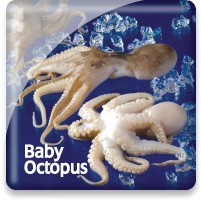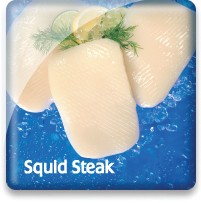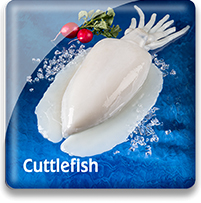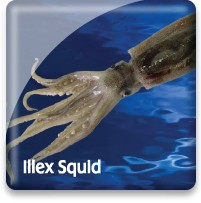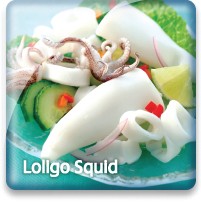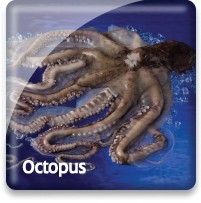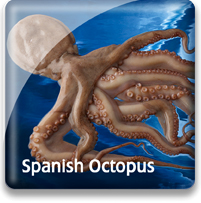
Spanish Octopus

Market Name: Eating QualitiesRaw Spanish Octopus should smell of the ocean. Raw octopus is purplish in color. When cooked, the purple skin conceals a fairly translucent white meat. The flesh is very firm and somewhat chewy and has a mild almost sweet flavor. All parts of the octopus can be consumed and are either eaten boiled, fried, grilled or stewed.
An adult octopus can squeeze through a hole the size of a dime.
|
Description & CharacteristicsSea Port’s Spanish Octopus is sourced from Spain where there is a long seafood tradition of celebrating this unique taste treat from the sea. They value their octopus so much that they are true artisans when it comes to both harvesting and processing and this creates the best quality octopus on the market. Most of the catch comes right off the Spainish coastline on the Atlantic side. Sea Port’s Spanish Octopus can add that little something special to your menu. Please join the Spanish celebration of Octopus today……..Es Fantastico!
Other Resources |
Handling Instructions for Spanish Octopus
Our frozen Spanish Octopus should be stored at or below 0°F (-18°C) and then thawed properly when ready to cook. Our salmon portions and skin-on fillets are individually vacuumed packed to provide single serve convenience and to protect against freezer dehydration. The frozen shelf life of our Atlantic salmon is 12-18 months. Links to proper handling of seafood: NOAA - Fish Watch: Handling Seafood and A Consumer Guide to Safe Seafood Handling.
Thawing Spanish Octopus
Spanish Octopus can be thawed under refrigeration between 33 and 39°F until it is completely thawed. The thawing time is dependent upon if the octopus is IQF or block frozen. IQF octopus will thaw between 24 and 48 hours depending upon the size of the octopus and block frozen will take up to 48 hours or longer. However, IQF and block frozen octopus can be quickly thawed by placing the product in a colander and running under cold water until thawed. In general, IQF octopus will thaw within several minutes while the block frozen may take 10 to 20 minutes or longer. This is our preferred quick thawing method to use whenever possible.
Important Instructions for Spanish Octopus
Thawed raw Spanish Octopus should be used immediately or within 1-2 days due to the fact that octopus in general has a relatively short thawed shelf life.
Cooking Tips
Spanish Octopus can be challenging to cook to a tender pleasing texture. This is especially true for the larger sizes that can run over 13 pounds. The smaller sized octopuses running less than 1/4th of a pound are less complicated to prepare. However, larger whole octopuses need to be boiled and tested periodically for tenderness during the cooking process. Because of this, our conveniently precooked octopus from Japan is gaining in popularity. Links to cooking tips and recipes: Fish & Seafood Cooking and Recipes
Spain
Spain is the second largest country in the European Union. It covers about 85 percent of the Iberian Peninsula, which it shares with Portugal. Its coastline includes parts of the Mediterranean Sea and the Atlantic Ocean. Its Fisheries consist of marine wild catch and aquaculture.
Spain’s wild capture fisheries produce about five times more than its aquaculture sector. Spain has the third largest fishing fleet in Europe and targets tuna, needlefish, cod, hake, herring, sardines, anchovies and crustaceans and molluscs consisting of shrimp, squid, cuttlefish, and octopus. The aquaculture sector produces mussels, turbot, seabass, seabream, sole, trout, eel, and sturgeon. Mussels are Spain’s largest farm raised species by volume.
Spain has the largest seafood processing infrastructure in Europe and is one the top European importers of seafood to supply its extremely strong domestic demand. The people of Spain love seafood and have a great passion for all the delicious fruits of the sea and aquaculture. Because of this seafood passion, Spain not only produces very high quality seafood, but also looks to constantly improve its wild fisheries and aquaculture production systems.
|
*Click here for an explanation of our Sustainability Spectrum Sustainability AssessmentTraditional methods of capturing Octopus are usually relatively benign from an environmental standpoint. However, common concerns that exist in many Octopus fisheries are:
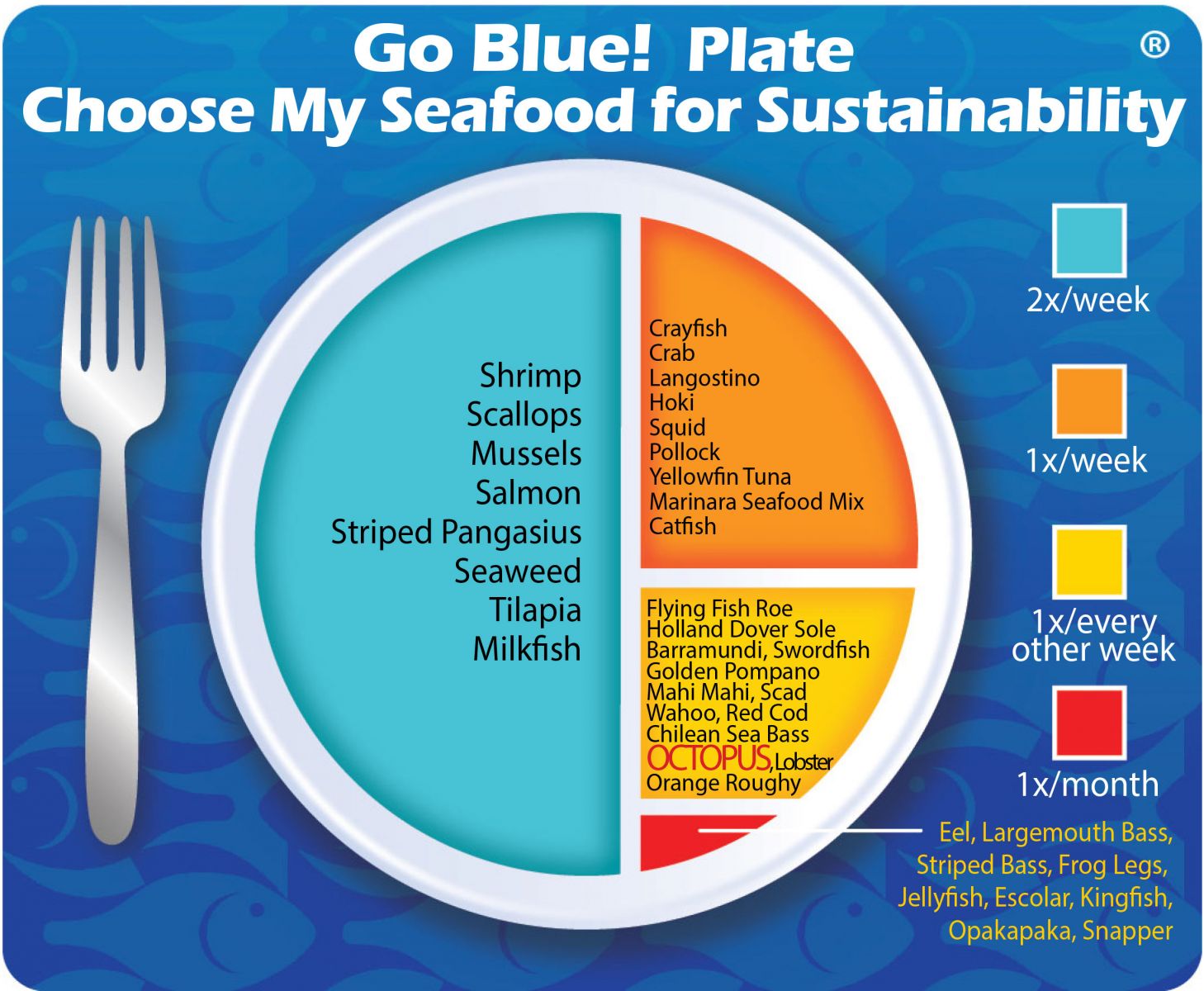
Environmental Impact: Moderate to HighLack of information about their ecological role as well as outstanding questions about the connections between local environmental conditions and population health make robust assessments of the Octopus fishery difficult. Many Octopus fisheries also exhibit a serious lack of regulation and/or enforcement.
Sustainability Improvements NeededThere is a need for more data and information on Octopus from fisheries (e.g., location, landings, fishing effort, size of octopus being caught) as well as from scientists (e.g., ecological role of Octopus, reproductive strategies). This information can be used to assess the current state of the Octopus resource as well as determining what regulations may be necessary to sustain healthy populations.
Actions that Sea Port is UndertakingWe created the sustainability assessments for each of our seafood items in order to reveal the existing and potential environmental impacts and risks that are associated with producing them for human consumption. This allowed us to establish the starting position for each of our seafood items along our progressive Go Blue! Seafood Sustainability Spectrum®. These assessments are only a single snapshot in time and because of this, we will continue to assess and update the critical sustainability needs associated with our supply sources and issue updates to the Go Blue! Seafood Sustainability Spectrum® as needed. There is a growing global awareness for the need to assure the sustainability of farmed and wild caught seafood and because of this; all around the world positive changes are rapidly occurring at all levels of the seafood supply chain. We will continue to spread this growing awareness and work with our many industry partners to improve the sustainability of all seafood, which we believe is the ideal protein of choice to feed an ever growing world population. Our Go Blue! Seafood Sustainability Spectrum® serves as our compass and yardstick as we strive to move all our products forward to becoming more sustainable. Please join us in this committed quest and Catch Our Wave® to sustainability by choosing a diverse variety of responsibly produced seafood as part of your diet.
|



